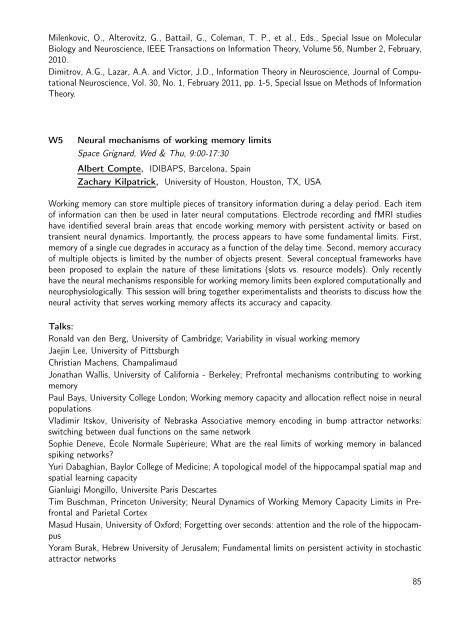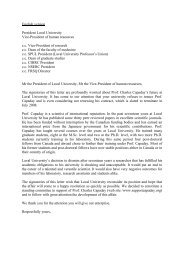Untitled - Laboratory of Neurophysics and Physiology
Untitled - Laboratory of Neurophysics and Physiology
Untitled - Laboratory of Neurophysics and Physiology
You also want an ePaper? Increase the reach of your titles
YUMPU automatically turns print PDFs into web optimized ePapers that Google loves.
Milenkovic, O., Alterovitz, G., Battail, G., Coleman, T. P., et al., Eds., Special Issue on Molecular<br />
Biology <strong>and</strong> Neuroscience, IEEE Transactions on Information Theory, Volume 56, Number 2, February,<br />
2010.<br />
Dimitrov, A.G., Lazar, A.A. <strong>and</strong> Victor, J.D., Information Theory in Neuroscience, Journal <strong>of</strong> Computational<br />
Neuroscience, Vol. 30, No. 1, February 2011, pp. 1-5, Special Issue on Methods <strong>of</strong> Information<br />
Theory.<br />
W5<br />
Neural mechanisms <strong>of</strong> working memory limits<br />
Space Grignard, Wed & Thu, 9:00-17:30<br />
Albert Compte, IDIBAPS, Barcelona, Spain<br />
Zachary Kilpatrick, University <strong>of</strong> Houston, Houston, TX, USA<br />
Working memory can store multiple pieces <strong>of</strong> transitory information during a delay period. Each item<br />
<strong>of</strong> information can then be used in later neural computations. Electrode recording <strong>and</strong> fMRI studies<br />
have identified several brain areas that encode working memory with persistent activity or based on<br />
transient neural dynamics. Importantly, the process appears to have some fundamental limits. First,<br />
memory <strong>of</strong> a single cue degrades in accuracy as a function <strong>of</strong> the delay time. Second, memory accuracy<br />
<strong>of</strong> multiple objects is limited by the number <strong>of</strong> objects present. Several conceptual frameworks have<br />
been proposed to explain the nature <strong>of</strong> these limitations (slots vs. resource models). Only recently<br />
have the neural mechanisms responsible for working memory limits been explored computationally <strong>and</strong><br />
neurophysiologically. This session will bring together experimentalists <strong>and</strong> theorists to discuss how the<br />
neural activity that serves working memory affects its accuracy <strong>and</strong> capacity.<br />
Talks:<br />
Ronald van den Berg, University <strong>of</strong> Cambridge; Variability in visual working memory<br />
Jaejin Lee, University <strong>of</strong> Pittsburgh<br />
Christian Machens, Champalimaud<br />
Jonathan Wallis, University <strong>of</strong> California - Berkeley; Prefrontal mechanisms contributing to working<br />
memory<br />
Paul Bays, University College London; Working memory capacity <strong>and</strong> allocation reflect noise in neural<br />
populations<br />
Vladimir Itskov, Univerisity <strong>of</strong> Nebraska Associative memory encoding in bump attractor networks:<br />
switching between dual functions on the same network<br />
Sophie Deneve, École Normale Supérieure; What are the real limits <strong>of</strong> working memory in balanced<br />
spiking networks<br />
Yuri Dabaghian, Baylor College <strong>of</strong> Medicine; A topological model <strong>of</strong> the hippocampal spatial map <strong>and</strong><br />
spatial learning capacity<br />
Gianluigi Mongillo, Universite Paris Descartes<br />
Tim Buschman, Princeton University; Neural Dynamics <strong>of</strong> Working Memory Capacity Limits in Prefrontal<br />
<strong>and</strong> Parietal Cortex<br />
Masud Husain, University <strong>of</strong> Oxford; Forgetting over seconds: attention <strong>and</strong> the role <strong>of</strong> the hippocampus<br />
Yoram Burak, Hebrew University <strong>of</strong> Jerusalem; Fundamental limits on persistent activity in stochastic<br />
attractor networks<br />
85



